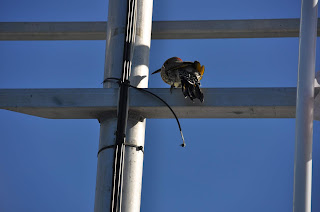This week on campus we have students from three schools within the Ottawa-Carleton District School Board: Earl of March Secondary School and South Carleton and Osgoode Township High Schools. The students are introduced to marine biology in the lab and in the field while exploring around
St. Andrews and
Grand Manan Island.
Identifying plankton collected from the bay while on the research vessel, the Fundy Spray.
View of plankton at 40x magnification.
Skate egg in the touch tank.
Sorting through the animals collected from the bottom of the bay.
brittle star
jonah crab
shrimp
Gathering data on the temperature and salinity of the water at different depths.
Collecting plankton to study in the lab.
Day 2 began by drawing and describing the animals collected from the bay.
Learning to use field guides for identification.
Exploring the intertidal zone at low tide.
The students found animals, such as sea stars and urchins hiding under the rocks.
Searching for invasive green crabs.
Data is gathered on the size and gender of each crab that is found.
On the ferry headed to Grand Manan Island.
Checking out a local delicacy, dulse.
Making a dichotomous key using the collected seaweeds.
The challenge was to find the longest seaweed with the holdfast, stipe and blade.
Lobster 101 - learning about the lobster industry from Captain Peter Wilcox.
Peter is busy preparing his trips for the upcoming lobster season in November.
Basalt cliffs at Southwest Head.
There were lots of seals seen in the water below the cliffs.
We went whale watching with
Seawatch Tours. We saw a fin whale and minke whale what we didn't catch photos of. Thank you to one of the students for the following pictures!
We had a Northern flicker tagging along.
We spotted a fin in the water...
and it was an ocean sunfish (Mola mola)!
We found a humpback whale rolling in a patch of seaweed on the surface. The humpback is laying on its side. We can see the ventral grooves and a pectoral fin.
Dorsal fin
Sticking it's head out of the water.
One side of the fluke.
Pectoral fin in the air.
Notice the tubercles (bumps) on the humpback's face.
Pectoral fin in the air.
Humpbacks can be identified by the unique pattern on the bottom of their flukes. This whale is
Patches. Patches is a male and is at least 38 years old.
The group divided to complete various behaviour experiments. This group is studying the effect of temperature on the feeding rate of barnacles.
Does size affect the flipping rate of sea urchins?





























































